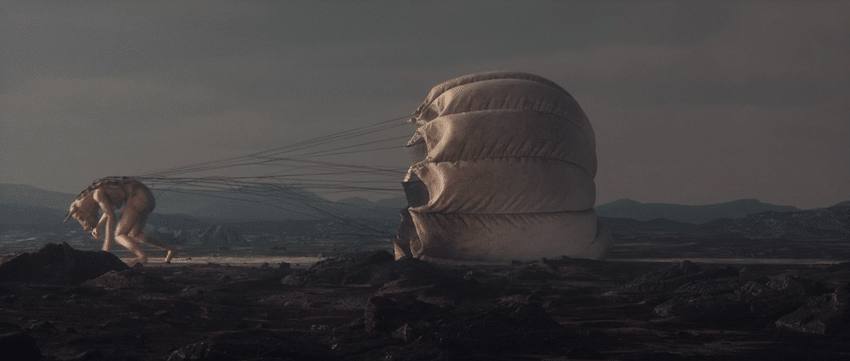“To See One’s Own Reflection is a Rare Occurrence”
By Sharifa Moore
Artist Louis Crevier is based in Helsinki, Finland. His work has been featured in Supernova three times beginning with Hvatir in the competition in 2016, Phantasmata in Director’s Choice in 2019, and Sometimes I think about things, and sometimes I get sad winning the Grand Prize in the focal competition in 2021. Crevier produces work that is visually compelling, but that also reveals certain truths about the human condition. For our December artist feature, we wanted to take a deeper look at this award winning work and the conceptual undertones behind it.
Sometimes I think about things, and sometimes I get sad opens to a digital render of the artist sitting in an empty airplane. In the darkened cabin he is shown watching a screen on the seatback. On the display, a figure set amidst a blue cloudless sky slowly descends on a parachute. Overlaid with the imagery, a narrator gives context to the visual display through a smooth and rhythmic cadence. Crevier has said that the inspiration for this piece came from a similar situation in his life. He thought about the idea of a cartoon character falling out of the sky and the hole that is left when it hits the ground. This hole, that we can all envision from the cartoons of our youth, leaves a cutout in the shape of the figure, which in turn creates a trace of what was. In contrast, a real body falling into oblivion would leave nothing behind. This simple thought that makes reference to the humor of childhood provided a catalyst for pervasive thinking that stretches into the recesses of the collective fears of adulthood.
The film cuts to a wide expanse of an open desert as the backdrop for the figure gliding by parachute. It appears on screen as an anthropomorphized bull exhibiting a rendition of Sisyphus rolling his boulder up the mountain. In this version, the bull labors across the screen only to be blown backwards by the wind expanding the parachute. The bull labors alone in the vastness of a barren landscape. Emptiness echoes in each sequence of the film; a bathtub filling with water, a decaying swimming pool, the open ocean, immense waves against a gray sky, an endless horizon.
A bed slowly appears introducing a second anthropomorphized figure, this time with the head of a bird, reminiscent of Max Ernst’s alter-ego, Loplop. The bird engages in typical everyday activities. It awakes. It goes on a jog. It runs from a cycle of thoughts that attempt to frame life in positive terms, while the voice of doubt whispers in the background. Ultimately, the bird succumbs and sits in the detritus with its head buried into its knees. The philosopher Henri Bergson talked about the oscillation between what he referred to as the surface self and the fundamental self, which relates to the experience of many identities and cyclical thinking. This process does not result in a dialectic, but rather we find clarity only to observe as it diminishes. To put this into context with the realizations about our world is to acknowledge what we have to ignore in order to go on with our day.
Despite exploring different narratives, a quote from Hvatir comes to the forefront of interpretation with this piece: “To See One’s Own Reflection is a Rare Occurrence.” There are so many different versions of who we are as people. We perform our gender, professional interactions, the variations of our personal lives with friends, lovers, and family, and then there is who we are when we are alone. The condition of identity is constantly in flux and becomes complex when amplified by the realities of the world in which we live. To be human is to continually assimilate and adapt. More specifically, within Bergson’s theories, we experience life as a fluctuation of attachment and detachment.
In the next sequence of the film, the camera pans out from the bird to reveal that it is being watched on a screen inside an airport. We return to the artist as he waits for baggage to arrive via conveyor belt. Suitcases drift along in the empty airport followed by the bull and the bird laying stationary on the moving belt. They are unconscious, inactive, and naked versions of the self that are collected. Awaking under the harsh fluorescent lights, the three figures wait for an elevator to leave together. They exit onto a fog covered bridge where dual monitors sit atop a desk. The narrator recounts a conversation with his father and then talks about the practice of making artwork as one that keeps his mind busy and combats feelings of loneliness. While he works at the desk, the bird and the bull operate jackhammers to eliminate the pathways leading to the bridge, an analogy Crevier says speaks to the length of time it took to complete this film. The artist sits in isolation with his work. The screen goes red.
The best artworks allows us to reflect on ourselves. We produce meaning and create associations that provide the ability to perceive narrative in terms of individual lived experiences. Artwork doesn’t have to be about any specific situation, but instead speaks to the ways in which we encounter reality. Louis Crevier has provided an opportunity to sit with those things that make us sad, which conversely allows for an appreciation of the immense beauty we encounter through the embrace of the things we love, the connections we have with each other, and the bittersweet joy in the fleeting corporeality of existence.
Hvatir presented at Supernova Festival 2016, Denver, Colorado
Phantasmata presented at Supernova Festival 2019, Denver, Colorado
Works cited
Henri Bergson, Time and Free Will: An Essay on the Immediate Data of Consciousness (Mineola: Dover, 2001).
Henri Bergson, Matter and Memory (Brooklyn: Zone Books, 1991).
Watch Sometimes I think about things, and sometimes I get sad on Vimeo








